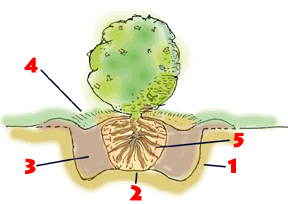Rootball - Planting and Care Guide
 ROOTBALL plants have an advantage as they come with the soil in the rootball and can only be moved when they are dormant (November - March). ROOTBALL plants are grown in the field and dug with a ball of soil around the roots. The soil and roots are wrapped with a biodegradable hessian wrap which will decompose with time. The hessian is held on the rootball with twine or is pinned in place with nails. The hessian wrap should be removed when planting. Do not let the root system of the plant dry out. Rootball plants should be planted within a few days of delivery and it is extremely important that they be kept well-watered the first year. Planting hole should have a good amount of water, place Rootball in, backfill and then drench again- winter weather will be a bonus. Rootball plants taller than 3ft can defoliate or suffer from yellowing leaves when the first hot weather appears first season after planting. This is due to plant shock due to the heat, and should be kept well-watered to help recover.
ROOTBALL plants have an advantage as they come with the soil in the rootball and can only be moved when they are dormant (November - March). ROOTBALL plants are grown in the field and dug with a ball of soil around the roots. The soil and roots are wrapped with a biodegradable hessian wrap which will decompose with time. The hessian is held on the rootball with twine or is pinned in place with nails. The hessian wrap should be removed when planting. Do not let the root system of the plant dry out. Rootball plants should be planted within a few days of delivery and it is extremely important that they be kept well-watered the first year. Planting hole should have a good amount of water, place Rootball in, backfill and then drench again- winter weather will be a bonus. Rootball plants taller than 3ft can defoliate or suffer from yellowing leaves when the first hot weather appears first season after planting. This is due to plant shock due to the heat, and should be kept well-watered to help recover.
- When excavating for planting of rootballed stock, plant in good quality soil, at least 300mm clearance should be allowed between the rootball and the edge of the pit to facilitate staking and guying and to allow for an adequate amount of backfill between the rootball and edge of the it. The depth of the rootball should be measured and the pit excavated to the depth which will accommodate the whole rootball.
- When introducing the rootball into the prepared pit it must be settled in firmly on the bottom and be standing upright. Placing rootball in the planting area must be done carefully, pickuing up the plant by cupping the rootball and not by the trunk and dropping into the planting area.
- Before removing the wire and rope / twine partially backfill to support the rootball. Carefully remove the wire and twine / rope from around 8-12" around the top of the rootball.
- Once the tree or plant is in position in the planting area, use wire cutters to cut vertically up the side of the wire and remove it carefully. Remove all the twine / rope from the ball as well as any nails that may be holding the ball together. Be carefull as the rootball must remain intact. Pull the hessian back carefully and cut away as much as is allowed. Do not worry about the hessian under the rootball, it can stay put as it will eventually biodegrade naturally.
- A layer of backfill should be placed on the filter material and firmed to prevent settlement of the rootball after planting. The level of the rootball should be checked and if necessary backfill added until it is judged that when placed in the pit the top of the rootball will be level with the top of the pit
- The top of the rootball is the nursery mark and it is a common fault and very bad practice to plant rootballs too deeply. It is better to leave the top slightly proud of the pit than to bury it too deeply
- When planting rootballed plants it is not necessary to remove the hessian and wire from the rootball.
- Do not fertilise at planting however the use of ROOTGROW would be beneficial. Do not fertilise luntil the first flush of growth takes place and then only a light fertiliser. Research has shown that newly planted trees / shrubs do not respond to fertilisation nor does fertiliser enhance root development.
- Avoild staking if you can. If you must stake use flexible bindings and wide straps. Remember to remove after one growing season.
This information is only a guide

